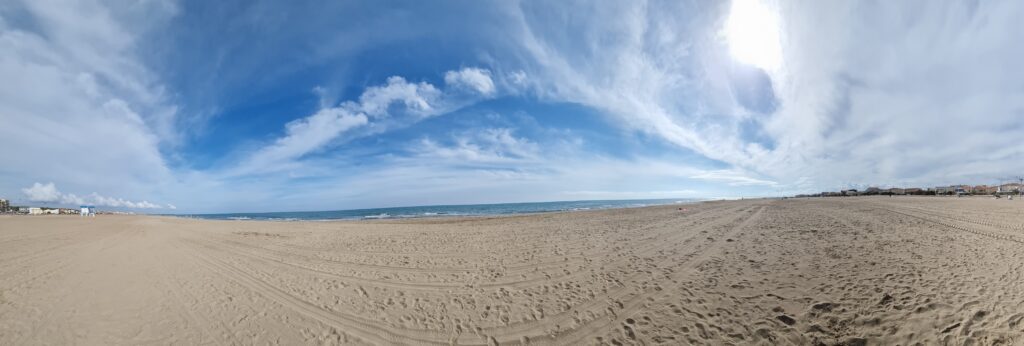
My 60th birthday celebrations, a couple of years ago now, centred around train journeys to the South of France and then onto Madrid. The highlight was (pictured above) spending a large part of my birthday, in mid October, on a huge deserted beach at Narbonne and being able to comfortably swim in the sea. So much space.
And the trains also seemed so much more spacious. I travel a lot on trains in the UK, with sometimes comedically little space. And I am not just talking about space in terms of leg room in European trains, but also whenever you want to walk over to the restaurant carriage on the upper floor of a double decker train to improve the views, with a bar and an array of kidney shaped tables dotted around the carriage to eat hot meals at, before ambling back to your seat. Mental space is much greater too, with fewer announcements and partitions between passengers to reduce the amount of conversation bouncing around the carriage. I had several 5-6 hour journeys over the two weeks I was away, and they were without exception very relaxing experiences.
So enough travelogue. What point am I making? It is the importance of space.
I think of other things where my view of it has been affected by the space attached to it. Take swimming, for example. I spent three of my formative years (aged 3 to 6) in Singapore where my father was stationed with the RAF. We swam outdoors at the Singapore Swimming Club every afternoon and lived in flats right next to a beach. Swimming was all about space – on my back staring up at the limitless sky, or mask and snorkels on and face down to explore the depths of the pools.
Back in the UK, it has never been anything like the same experience. I have swum in pools in village schools in Yorkshire, council pools in Cheltenham and Witney, the pools built for the Youth Games in Sheffield, a private school’s tiny pool in Oxford where I did my bronze survival badge. Endless school outings with compulsory swim caps and cold water. I have swum in lakes and spent probably more time in the Cherwell than was strictly healthy, sometimes deliberately, sometimes because the canoes we were given at school were designed to be manoeuvrable rather than stable. I have swum in decaying metal structures in spa towns and pools fed by spring water with no heating in the Peak District. I only discovered body boarding relatively late and the joys of doing it for much longer in colder seas with a wetsuit even later (last year). I also spent a fascinating morning with the Wild Woman of the Wye, Angela Jones, learning how to swim safely in the river in our current polluted times. And it certainly feels like the decline in swimming quality in recent years extends indoors as well as outdoors. The Wyndley or Beeches Leisure Centres near my part of Sutton Coldfield just don’t hold much appeal for me. Sure there are bodies of water there, but nothing to lift your spirit while using them and the constraints, in terms of the narrow time slots and even narrower lanes you are confined to, are the very opposite of my earliest experiences of water. I am lucky enough to be able to afford the local David Lloyd Centre, with much less pressure on their pools, in particular their excellent outdoor pool in Birmingham, which is miraculously underused. On a day with bright sun, with the birds singing and a light breeze rustling the trees just enough to drown out the industrial hum from next door and push back the smell of solvents, I can sometime almost imagine I am back in the Singapore Swimming Club.
But generally when you attempt to venture outside you find the constraints are even greater than those at Wyndley swimming pool. According to the Right to Roam campaign group we only have access to 3% of rivers in England. Meanwhile the Outdoor Swimming Society are campaigning for swimming access to reservoirs.
On land we have slightly more access, but half of the land area of England is owned by around 1% of the population. As Guy Shrubsole points out:
The aristocracy and landed gentry still own around 30% of England, whilst the country’s homeowners own just 5% of the land. The public sector owns around 8% of England; the country’s 24 non-Royal Dukes own a million acres of Britain.
I can only redistribute some space in my direction, on a train, in a pool of water, by paying more than most can afford for those experiences, and allowing me to behave like a non-Royal Duke for a short time.
This has huge implications for carbon sequestration of course, with, for example, 60% of deep peat owned by just 124 landowners. These landowners are not looking after it very well either, with upland peat being degraded as a result of moorland burning for grouse moors, and lowland peat in the Fens and elsewhere being damaged through drainage for intensive agriculture. As a result, England’s peat soils are now a net source of carbon emissions rather than a sink, leaking around 11 million tonnes of CO2 annually. The Government has committed to protecting 30% of land in the UK for nature by 2030, but is itself hugely constrained by the concentrated ownership of land.
So our land is like our swimming pools: tightly constrained by the narrow time slots and narrower lanes most of us are allowed access to. We are being stifled by the property rights of a tiny minority.
